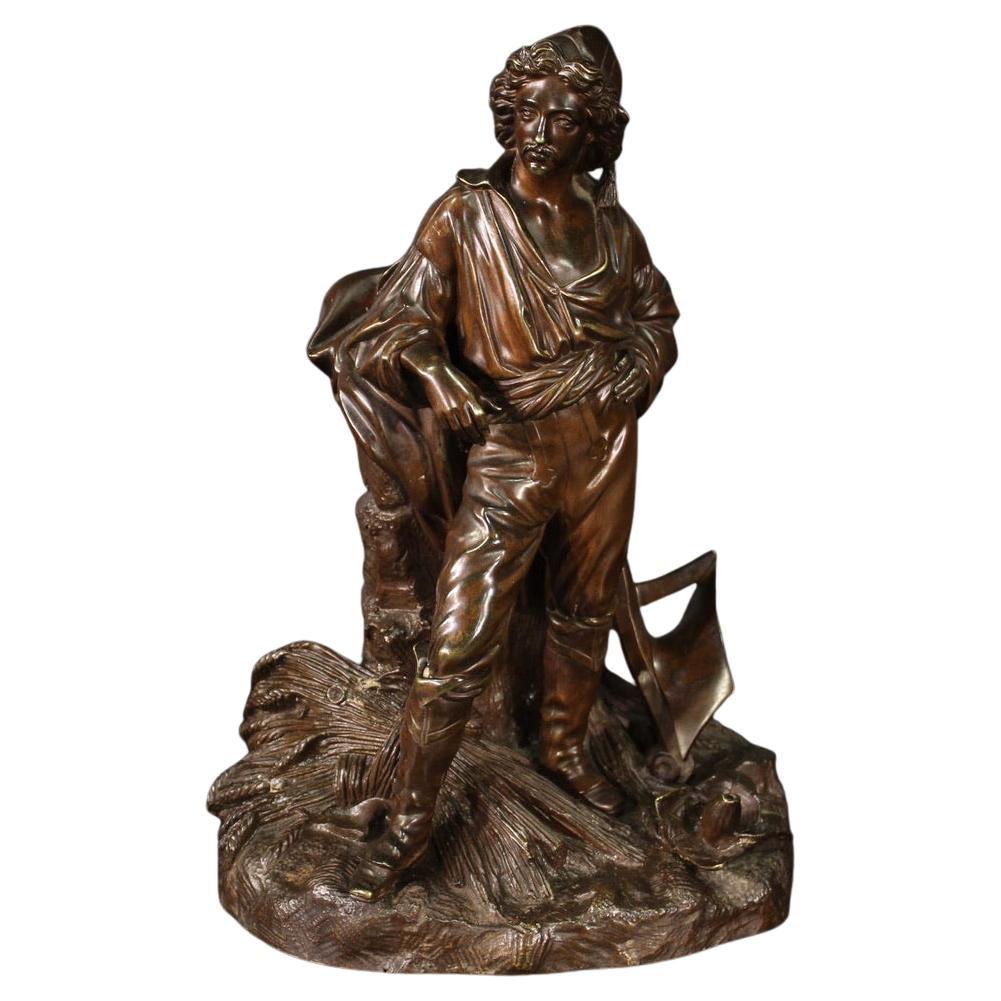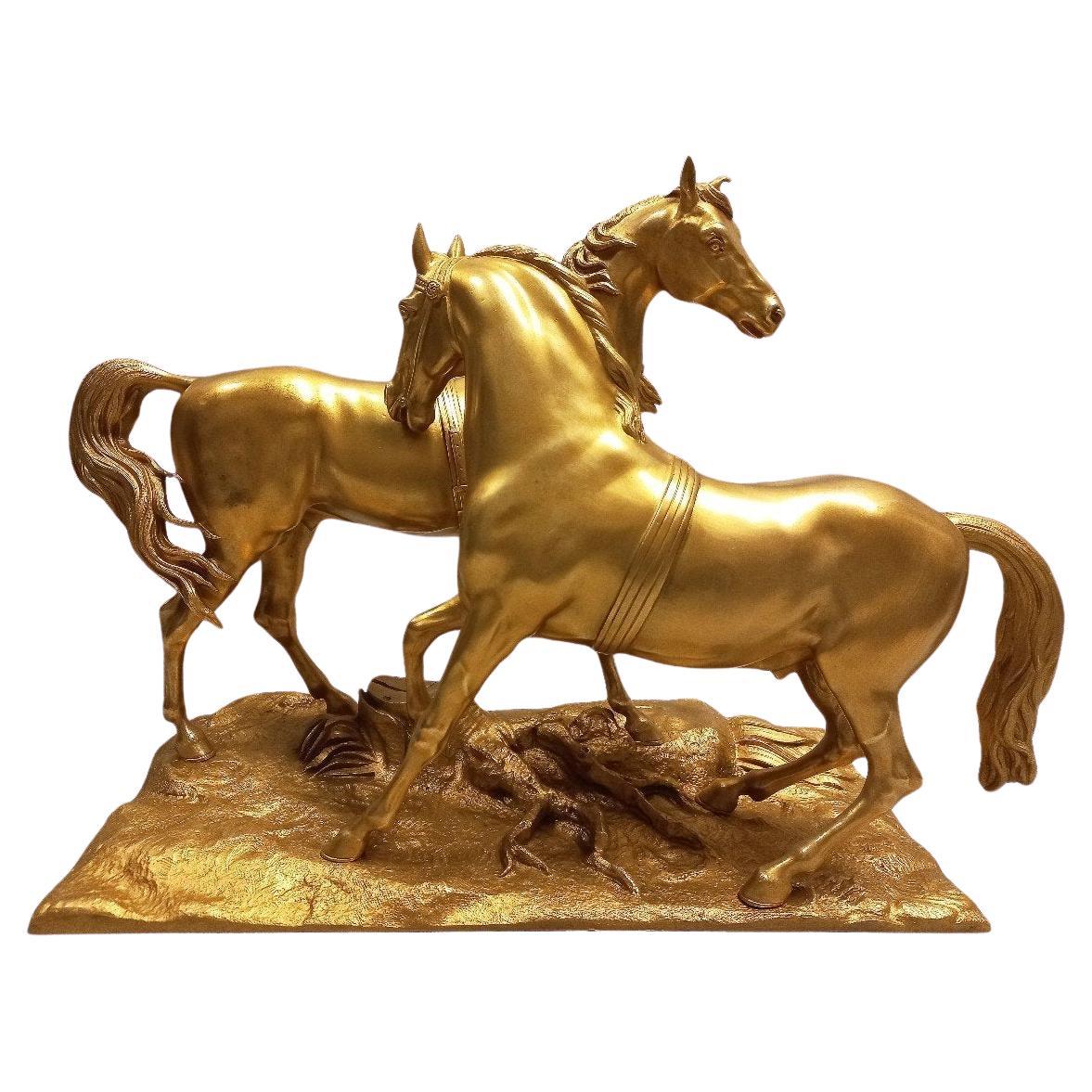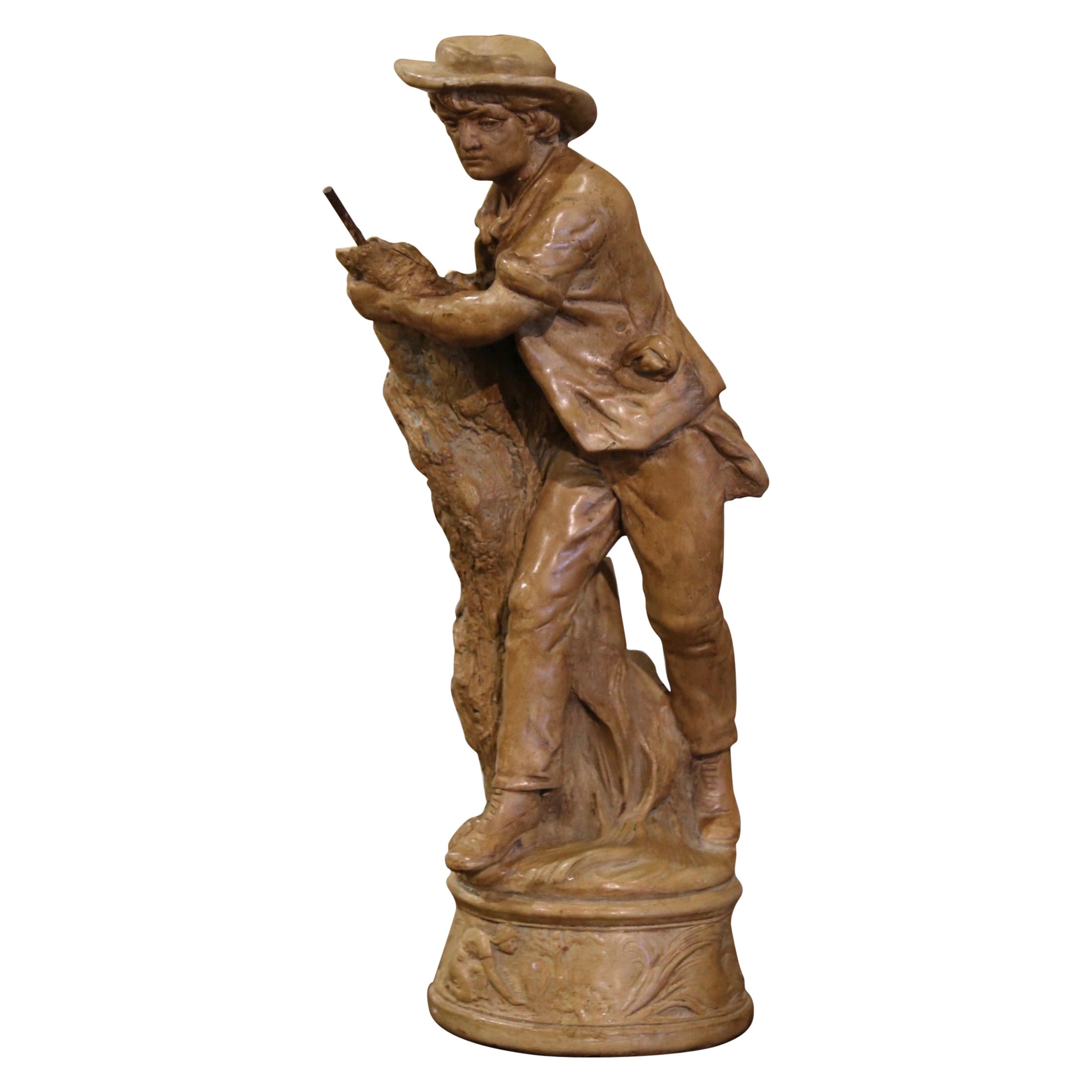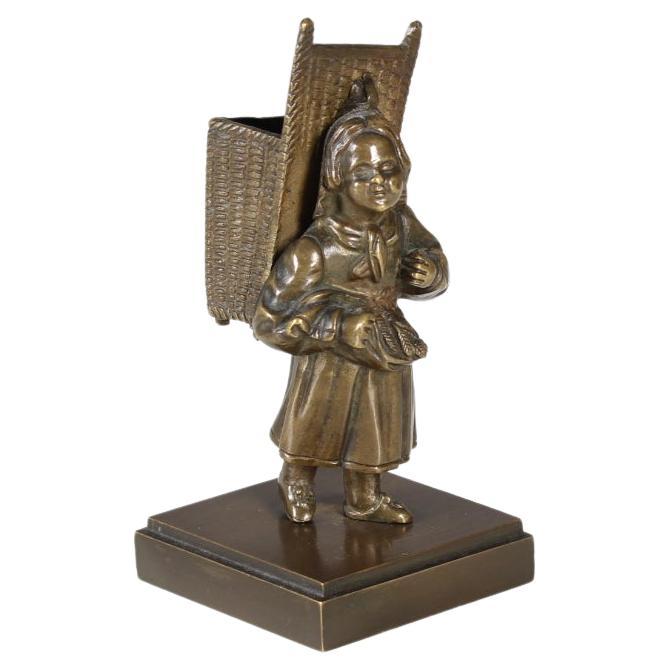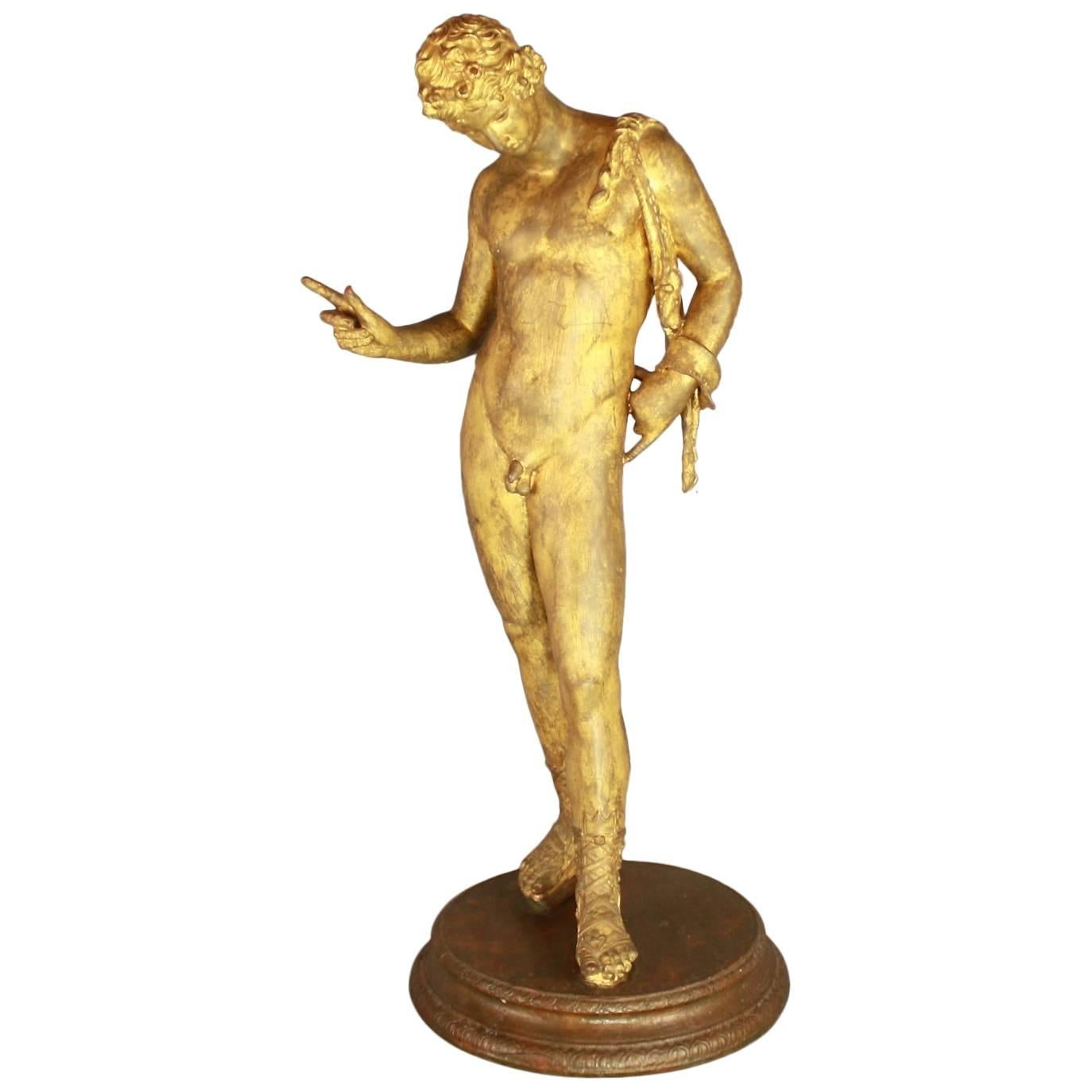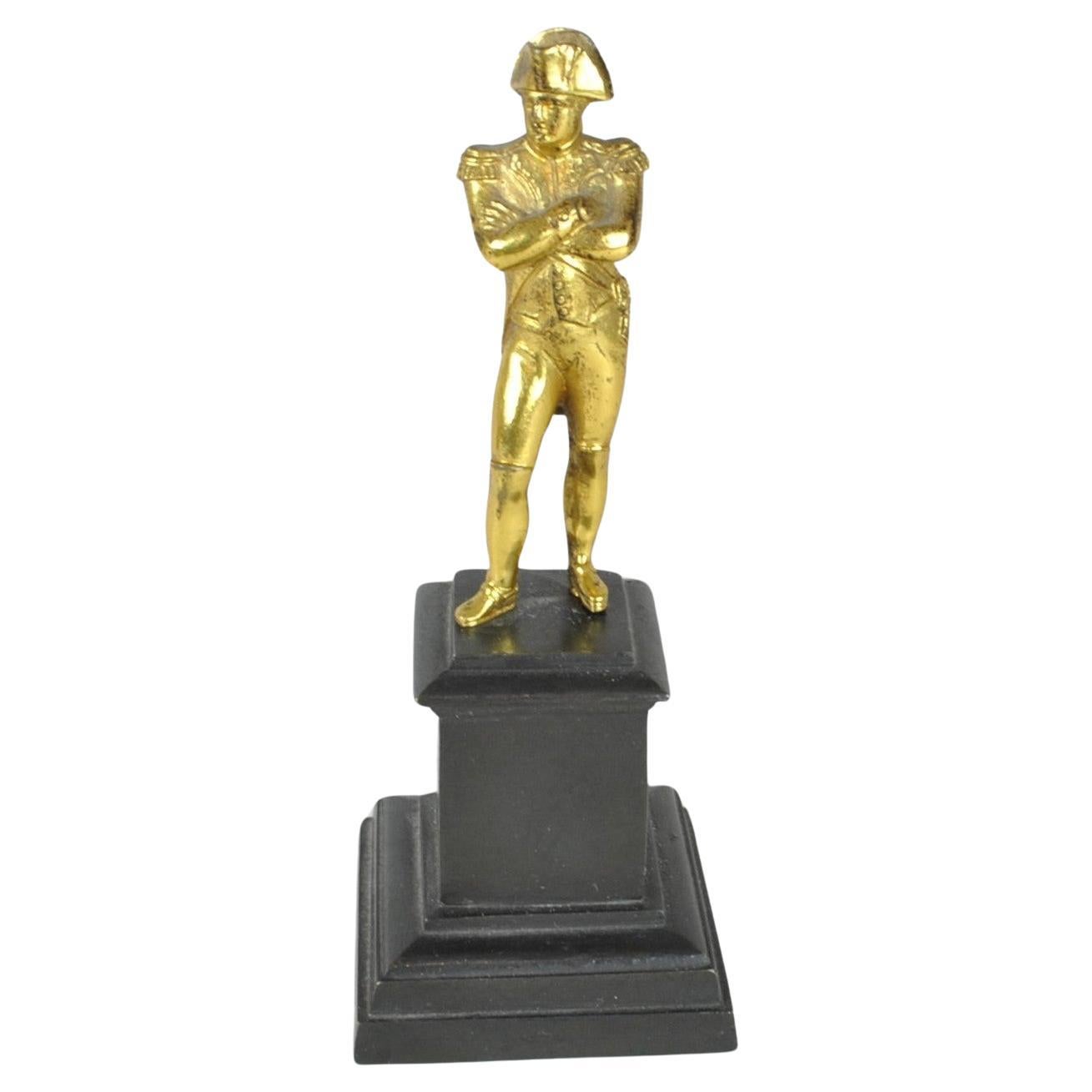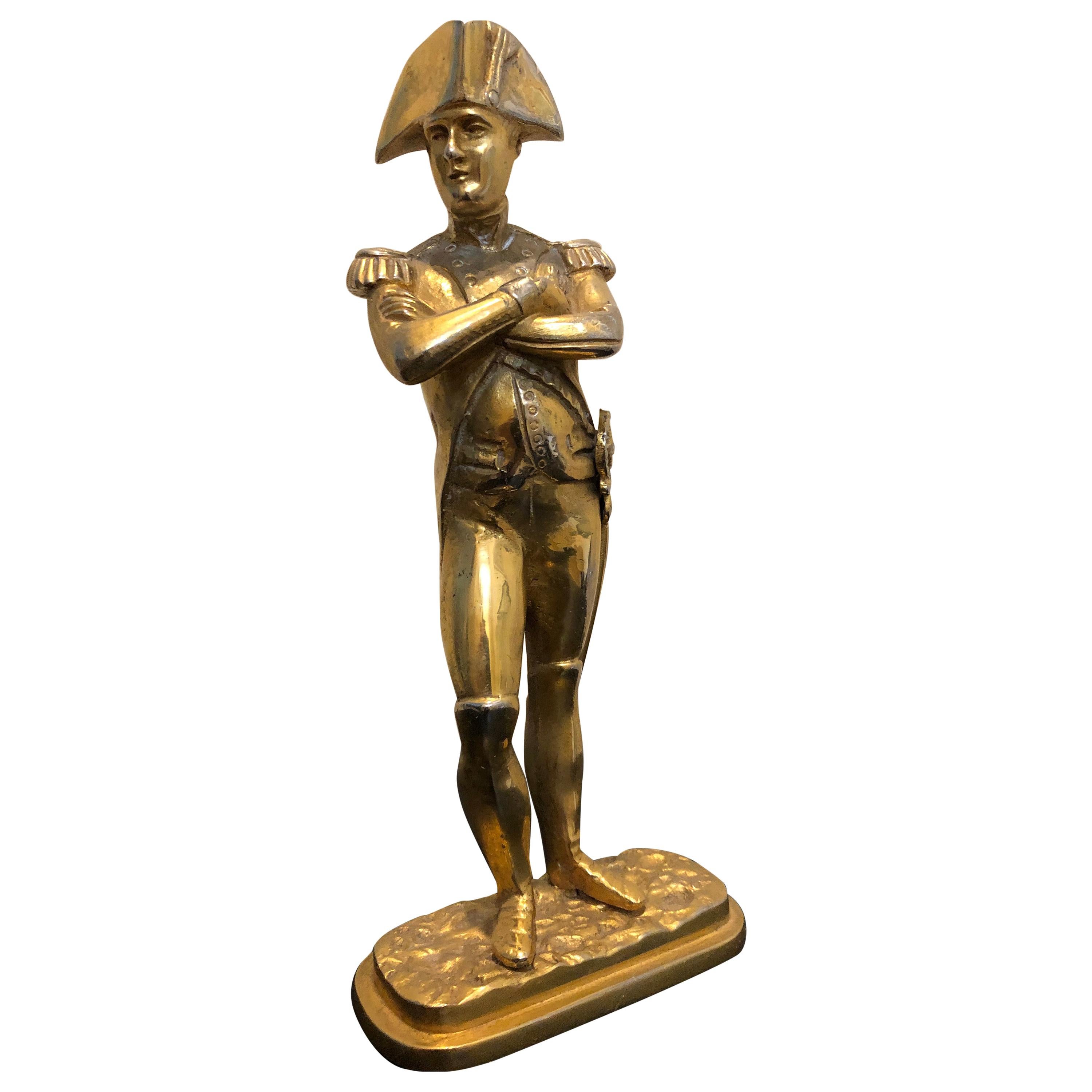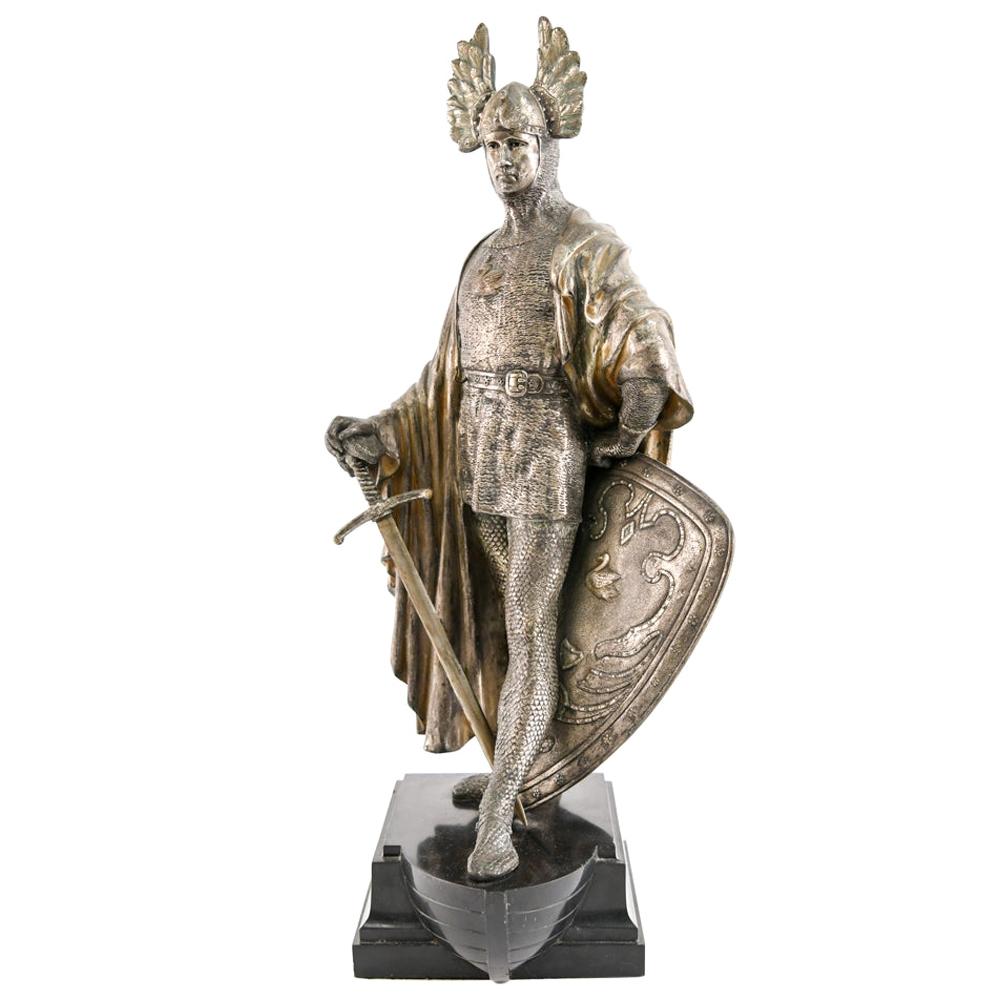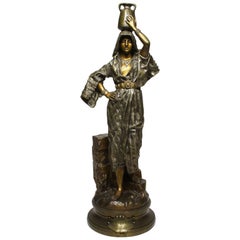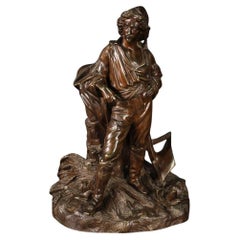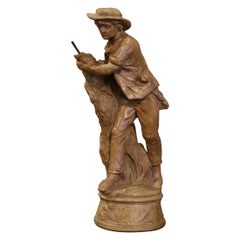
Rudolf Winder, 19th Century Gilt-Bronze Sculpture "Farmers"
View Similar Items
Want more images or videos?
Request additional images or videos from the seller
1 of 11
Rudolf Winder, 19th Century Gilt-Bronze Sculpture "Farmers"
About the Item
- Creator:Rudolf Winder (Sculptor)
- Dimensions:Height: 13.5 in (34.29 cm)Width: 19.13 in (48.6 cm)Depth: 7.38 in (18.75 cm)
- Style:Folk Art (In the Style Of)
- Materials and Techniques:
- Place of Origin:
- Period:
- Date of Manufacture:circa 1890
- Condition:Wear consistent with age and use. A truly beautiful and great quality sculpture. Fine chasing and attention to detail.
- Seller Location:Los Angeles, CA
- Reference Number:Seller: Ref.: A21001stDibs: LU179628496213
About the Seller
5.0
Vetted Seller
These experienced sellers undergo a comprehensive evaluation by our team of in-house experts.
Established in 1982
1stDibs seller since 2016
114 sales on 1stDibs
More From This SellerView All
- Pair French 19th/20th Century Gilt-Bronze Sculptures of The Marly Horses LampsBy Guillaume CoustouLocated in Los Angeles, CAA Fine Pair of French 19th/20th Century Gilt-Bronze Sculptures of "The Marly Horses" (Now turned into lamps) After the original by Guillaume Coustou (French, 1677-1746). The large pair of equestrian bronze sculptures, finished in a gold patina, each depicting rearing horses with their groom, both raised on oval a black slate and Bardiglio marble bases and fitted with modern electrical twin-light brass fittings and cream colored shades. The base on an ebonized wooden platform. Circa: Paris, 1900-1920. Sculpture & Base Height: 31 1/4 inches (79.8 cm) Base Width: 21 3/4 inches (55.3 cm) Base Depth: 12 3/4 inches (32.4 cm) Height to top of (Adjustable) shade fitting: 48 1/4 inches (122.6 cm) Shade Height: 15 inches (38.1 cm) Shade Width: 26 inches (66.1 cm) Shade Depth: 20 inches (50.8 cm) The original Marly Horses are two 1743–1745 Carrara marble sculpted groups by Guillaume Coustou. They were commissioned by Louis XV of France for the trough at the entrance to the grounds of his château de Marly. Coustou's last works, they were intended to replace two other sculpted groups, Mercury on Pegasus and Pegasus, Renown of Horses, both by Antoine Coysevox, which had been removed to the Tuileries Gardens in 1719. Louis XV chose the modellos in 1743 and the full-size sculptures were completed in only two years, being installed at Marly in 1745. They proved highly successful in reproduction, particularly on a smaller scale, and prefigured Théodore Géricault and other Romantic artists' obsession with equestrian subjects. The Marly horses were later also used as the central motif of the monochrome 819-line RTF/ORTF test card which was used on TF1 from 1953 until 1983. The originals were moved to the place de la Concorde in Paris in 1794 and Louis-Denis Caillouette (1790–1868) restored them in 1840. In 1984 it was concluded that the annual military parades on 14 July were damaging the sculptures and they were replaced by marble copies produced by Michel Bourbon in the studio of a subsidiary of Bouygues. The latter also gained the right to an extra copy, which was placed in Bouygues's social building. The original sculptures were moved to a former courtyard in the Richelieu wing of the Louvre Museum, which was renamed the 'cour Marly' in their honour, whilst Bourbon's two main copies were moved to the originals' first site near the trough at Marly, with work overseen by the architect Serge Macel. Guillaume Coustou the Elder (29 November 1677, Lyon – 22 February 1746, Paris) was a French sculptor of the Baroque and Louis XIV style. He was a royal sculptor for Louis XIV and Louis XV and became Director of the Royal Academy of Painting and Sculpture in 1735. He is best known for his monumental statues of horses made for the Chateau of Marly, whose replicas now stand in the Place de la Concorde in Paris. Coustou was a member of a family of famous sculptors; his uncle, Antoine Coysevox, was a royal sculptor; his elder brother, Nicolas Coustou was a sculptor, and his son Guillaume Coustou the Younger also become a noted royal sculptor. Like his older brother, he won the (Prix de Rome) of the Royal Academy which entitled him to study for four years at the French Academy in Rome. However, he refused to accept the discipline of the academy, gave up his studies, set out to make his own career as an artist. He worked for a time in the atelier of the painter Pierre Legros, and eventually returned to Paris. Upon his return to Paris, he assisted his uncle Coysevox in making two monumental equestrian sculptures, Fame and Mercury, for the Château de Marly, the new residence of Louis XIV near the Palace of Versailles, where he went to escape the crowds and ceremony of the Palace. He later (1740–1745), made his own horses, The Horses of Marly, his most famous works, to replace them. The horses reinvent the theme of the colossal Roman marbles of the Horse Tamers in the Piazza Quirinale, Rome. They were commissioned by Louis XV in 1739 and installed in 1745 at the Abreuvoir ("Horse Trough") at Marly. The horses were considered masterpieces of the grace and expressiveness of the French Late Baroque or Rococo style. After the Revolution they were moved from Marly to the beginning of the Champs-Élysées on the Place de la Concorde. The originals were brought indoors for protection at the Louvre Museum in 1984. In 1704 Coustou was received into the Académie royale de peinture et de sculpture. The work he made to mark his entrance was Hercules on the Pyre, now in the Louvre. It displays the special hallmark of the Baroque, a twisting and rising transverse pose, as well as highly skillful carving. He rose to become Director of the academy in 1733. Another of his major works from his later career, the statue of Maria Leszczynska, (1731)is on display at the Louvre. Coustou also created two colossal monuments, The Ocean and the Mediterranean among other sculptures for the park at Marly; the bronze Rhone, which formed part of the statue of Louis XIV at Lyons, and the sculptures at the entrance of the Hôtel des Invalides. Of these latter, the bas-relief representing Louis XIV mounted and accompanied by Justice and Prudence was destroyed during the Revolution, but was restored in 1815 by Pierre Cartellier from Coustou's model; the bronze figures of Mars and Minerva (1733–34), on either side of the doorway, were not interfered with. In 1714 for Marly he collaborated in two marble sculptures representing Apollo Chasing Daphne (both at the Louvre), in which Nicolas Coustou sculpted the Apollo and Guillaume the Daphne. About the same time he was commissioned to produce another running figure in marble, a Hippomenes designed to complement an Atalanta copied from the Antique by Pierre Lepautre...Category
Antique Early 1900s French Louis XV Animal Sculptures
MaterialsMarble, Bronze
- After Gaston Leroux French 19th Century Bronze Sculpture of RebeccaBy Gaston Veuvenot LerouxLocated in Los Angeles, CAA fine French 19th-20th century orientalist silvered and gilt patinated bronze sculpture of "Rebecca" with a plaque that reads "Jeune Fille Arabe" (A Young Arab Girl - Water-Carrier)...Category
Antique Early 1900s French Greco Roman Figurative Sculptures
MaterialsBronze
$4,950 Sale Price47% Off - Cipri Adolf Bermann, German, 19th Century Gilt-Bronze Bacchus Herm TermBy Cipri Adolf BermannLocated in Los Angeles, CACipri Adolf Bermann (German, 1862-1942) a very fine 19th century gilt-bronze miniature figure of a Bacchus Herm, depicting Bacchus, also known as Dionysus, the god of the grape harve...Category
Antique Early 1900s German Louis XV Figurative Sculptures
MaterialsMarble, Bronze
$2,850 Sale Price42% Off - Pair French 19th Century Japonisme Style Gilt-Bronze & Marble Chenets, BouhonBy Bouhon Frères 1Located in Los Angeles, CAA fine pair of French 19th century Japonisme Louis XV style Gilt-Bronze and Marble Figural Chenets (Andirons) by BOUHON FRES, each depicting a flaming dragon atop an "L" shaped base surmounted with an allegorical gilt-bronze and marble urns with floral garlands and paw-feet, the base with a draped ormolu design and raised on tapered feet. Stamped: "B&H". Circa: Paris, 1890-1900. The bronziers Bouhon et Cie. Bouhon Frers. specialized in bronze-decorated fire-places and fire-fittings. These large and fine chenets are supreme examples of their output. The firm participated in the 1878 and 1900 Paris Expositions Universelles. Japonisme[a] is a French term that refers to the popularity and influence of Japanese art and design among a number of Western European artists in the nineteenth century following the forced reopening of foreign trade with Japan in 1858. Japonisme was first described by French art critic and collector Philippe Burty in 1872.[3] While the effects of the trend were likely most pronounced in the visual arts, they extended to architecture, landscaping and gardening, and clothing.[4] Even the performing arts were affected; Gilbert & Sullivan's The Mikado is perhaps the best example. From the 1860s, ukiyo-e, Japanese woodblock prints, became a source of inspiration for many Western artists.These prints were created for the commercial market in Japan. Although a percentage of prints were brought to the West through Dutch trade merchants, it was not until the 1860s that ukiyo-e prints gained popularity in Europe. Western artists were intrigued by the original use of color and composition. Ukiyo-e prints featured dramatic foreshortening and asymmetrical compositions. Japanese decorative arts, including ceramics, enamels, metalwork, and lacquerware, were as influential in the West as the graphic arts. During the Meiji era (1868–1912), Japanese pottery was exported around the world. From a long history of making weapons for samurai, Japanese metalworkers had achieved an expressive range of colours by combining and finishing metal alloys. Japanese cloissoné...Category
Antique Early 1900s French Japonisme Andirons
MaterialsMarble, Bronze, Ormolu
$18,450 Sale Price / set25% Off - A French 19th Century Bronze Sculpture Titled "La Sécurité" Eugène DelaplancheBy Eugène DelaplancheLocated in Los Angeles, CAA very fine French 19th century brown and parcel-gilt patinated bronze sculpture titled "La Sécurité" (The Security - Protection) after a model by Eugène Delaplanche (French, 1836–1891). Depicting a sitting young Maiden in a gilt-decorated armored suit and helmet, a lion skin on her back, holding a resting child on her arm. Raised on Rouge-Royal marble plinth inscribed "La Sécurité - Par E. Delaplanche - Salon des Beaux-Arts de Paris". Signed: E. Delaplanche and stamped with the importer's seal - Alberto Vignes y Ca - Buenos Aires, circa 1890. Measures: Height: 28 3/4 inches (60.3 cm). Width: 16 inches (40.7 cm). Depth: 14 inches (35.6 cm). Eugène Delaplanche (February 28, 1836 – January 10, 1891) was a French sculptor, born at Belleville (Seine). He was a pupil of Duret, gained the Prix de Rome in 1864 (spending 1864-67 at the Villa Medici in Rome) and the medal of honor in 1878. His "Messenger of Love" (1874), "Aurora" (1878), and the "Virgin of the Lillies" (1884), are in the Luxembourg. Other works by him are "Music - La Musique" (1878, Paris Opera House), called his masterpiece; "Eve After the Fall" (1869); "Maternal Instruction" (1875, Square of Sainte-Clothilde, Paris). He is also noted for his decorations in relief on vases of Haviland faience. His best work is naturalistic, but at the same time dignified and simple in line and shows sound mastery of technique. He is represented by 15 works in the Glyptothek, Copenhagen and in many other French museums and in churches. This sculpture of La Sécurité is after his 1884 sculptures...Category
Antique Late 19th Century French Belle Époque Figurative Sculptures
MaterialsMarble, Bronze
$19,450 Sale Price44% Off - Italian 19th Century Grand Tour Bronze Sculpture of Narcissus, after PompeiiLocated in Los Angeles, CAAn Italian 19th century grand tour - Greco Roman bronze sculpture of Narcissus, after the original sculpture excavated in 1862 at Pompeii. The green...Category
Antique 19th Century Italian Greco Roman Figurative Sculptures
MaterialsBronze
$1,985 Sale Price42% Off
You May Also Like
- 19th Century Bronze French Antique Farmer Sculpture, 1880Located in Vicoforte, PiedmontFrench sculpture from the late 19th century. Chiseled and patinated bronze work depicting a farmer posing with a plow and wheat. Nicely sized sculpture, ideal for inclusion in a coll...Category
Antique 1880s French Figurative Sculptures
MaterialsBronze
- 19th Century Gilt Bronze Horse SculptureLocated in CHALON-SUR-SAÔNE, FRGroup of horses on a naturalistic basis Sculpture in gilded and chiseled bronze Period 1st part of the 19th century France Unsigned Very good conditionCategory
Antique Early 19th Century French Beaux Arts Animal Sculptures
MaterialsBronze
- 19th Century French Terracotta Farmer SculptureLocated in Dallas, TXDecorate a gentleman's study or office with this antique earthenware figure. Sculpted in France, circa 1880, the terracotta statue depicts a farmer raking and harvesting his crops. T...Category
Antique Late 19th Century French Country Figurative Sculptures
MaterialsEarthenware, Terracotta
- Small Antique Bronze Sculpture, Late 19th Century, Kiepenkerl, Farmer GirlLocated in Greven, DEBeautiful, small bronze figure, probably a holder for matches. The pannier on the back of the sculpture can be used to store small items. For examp...Category
Antique Late 19th Century Unknown Figurative Sculptures
MaterialsBronze
$312 Sale Price25% Off - 19th Century Gilt-Bronze Sculpture of DionysosLocated in Berlin, DEThe gilt-bronze statue of a nude youthful Dionysus standing on his right leg. In contrapposto position sculpted with a well-defined musculature. The head is bent down with a contempl...Category
Antique Late 19th Century Italian Napoleon III Figurative Sculptures
MaterialsBronze
- 19th Century English Gilt Bronze Dead Finch SculptureLocated in Chicago, ILThis 19th-century English life-size gilt bronze sculpture delicately captures the poignant beauty of a dead finch, meticulously crafted with intricate detail. In Victorian England, d...Category
Antique 19th Century English Animal Sculptures
MaterialsBronze
